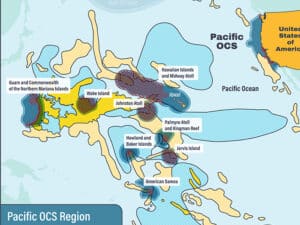
USCG now monitoring 5 Chinese research vessels in U.S. Arctic
Written by Nick Blenkey![A C-130J Hercules airplane crew from Coast Guard Air Station Kodiak responds to a Chinese research vessel operating in the U.S. Arctic as part of Operation Frontier Sentinel Aug. 13, 2025. [U.S. Coast Guard photo]](https://www.marinelog.com/wp-content/uploads/2025/08/250813-G-G0200-1004.jpg)
A C-130J Hercules airplane crew from Coast Guard Air Station Kodiak responds to a Chinese research vessel operating in the U.S. Arctic as part of Operation Frontier Sentinel Aug. 13, 2025. [U.S. Coast Guard photo]
Nobody likes having strangers rattling around in the attic and the U.S. Coast Guard is continuing its response to five Chinese research vessels operating in the U.S. Arctic.
The Coast Guard Arctic District has been monitoring activity and deployed a C-130J Hercules fixed wing aircraft from Air Station Kodiak Wednesday to query the vessels. In support of U.S. homeland defense and security efforts, the Coast Guard, in conjunction with U.S. Northern Command and Alaskan Command, constantly monitor the activity of foreign vessels operating in and near U.S. waters.
The Arctic is a growing zone of strategic global competition. The Coast Guard is the only U.S. surface presence in the Arctic and recently, in Alaska, commissioned U.S. Coast Guard Cutter Storis (WAGB 21), the former Edison Chouest Offshore icebreaking vessel Aiviq and now the service’s newest polar icebreaker, and U.S. Coast Guard Cutter Earl Cunningham (WPC 1159), the newest Sentinel-class fast response cutter.
“Commissioning the Storis and Earl Cunningham increases our ability to control, secure, and defend Alaska’s U.S. border and maritime approaches,” said Rear Adm. Bob Little, commander, U.S. Coast Guard Arctic District. “As we continue to grow our surface fleet, we utilize our aviation resources which play a vital role in countering foreign malign influence.”
The five Chinese Research Vessels are: Xue Long 2, China flagged; Shen Hai Yi Hao, China flagged; Zhong Shan Da Xue Ji Di, Liberia flagged; Ji Di, China flagged; and Tan Suo San Hao, China flagged.
The Liberian-flagged Zhong Shan Da Xue Ji Di has an interesting back story. It is operated by the Sun Yat-sen University and was built in 1983 as an icebreaking anchor handling tug supply vessel (AHTS) Ikaluk for BeauDril, the drilling subsidiary of Gulf Canada Resources, to support offshore oil exploration in the Beaufort Sea. After various ownerships and name changes, it was sold to China in February 2018 for scrap, but that didn’t happen and, after more name and role changes, in late 2021 was acquired by its current owner and given its current name.



![T-AO 209 seen during sea trials departing San Diego. [Photo: GD NASSCO]](https://www.marinelog.com/wp-content/uploads/2025/11/General_Dynamics_T_AO_209-300x225.jpg)
